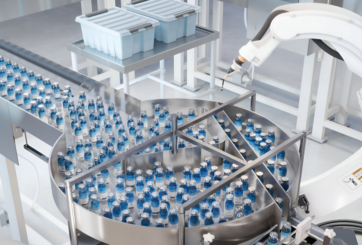Leveraging Plant-Floor Data to Optimize Operations
Today’s global pharmaceutical sector is facing challenges to become more efficient and streamlined like never before.

Constantly evolving patient demands, stringent regulatory requirements, increased competition, unpredictable financial markets, and issues sourcing essential materials are all forcing pharmaceutical manufacturers large and small to increase output while reducing downtime and rejects.
One of the ways that a forward-looking pharma business can increase productivity is to leverage the multitude of data available from its packaging operations. This data can be directly utilized to drive efficiency, reduce costs, and improve Overall Equipment Effectiveness (OEE).
This article will look at how data can be gathered from modern shop floor packaging lines and used by pharmaceutical firms looking to ensure they are maximizing quality and efficiency, both today and tomorrow.
Industry 4.0. and the rise of “smart” machines.
The “fourth industrial revolution”, “Industry 4.0.” or simply “4IR” is already surrounding us all and influencing the way that global pharma packaging operations are structured.
Industry 4.0. is directly responsible for vastly increasing the efficiency of packaging systems, products, and services by streamlining processes and maintaining data flow. Furthermore, the cloud has rewritten the way computing works, allowing firms to power and monitor their systems with a combination of on-premises and remote solutions.
The Industrial Internet of Things (IIoT) and cyber-physical systems are powering Industry 4.0. As a result of these smart machines that generate large amounts of data, the global pharmaceutical sector is becoming far more efficient, more productive, and less wasteful. In addition, legacy systems also provide a plethora of operational data that can be accessed through various methods.
By combining information from these new smart machines and a multitude of legacy controllers, we can gather production data relating to an entire packaging line having visibility to the overall line performance as well as the performance and reliability of the individual machines that make up the line.
This data is the untapped formula that many pharma firms are sitting on every day – a formula that can potentially translate into higher efficiency levels and increased profitability.
Opportunities to improve operations in pharmaceutical packaging.
The harvesting and effective analysis of plant floor data can lead to multiple operational benefits. Four of the top benefits include:
- Maintenance: Data analytics can enable predictive maintenance by analyzing real-time equipment performance data. Maintenance activities can now be scheduled before costly breakdowns occur, minimizing downtime and maximizing asset utilization. In addition, identifying the source of a breakdown immediately can result in quickly troubleshooting a problem and getting a line up and running with minimal downtime.
- Quality Control: Metrics can be analyzed throughout every stage of the packaging process, leading to the identification of trends and operational patterns. This provides an opportunity to implement corrective actions when required to minimize rejects while complying with quality standards.
- Improved Throughput: By monitoring each piece of equipment and integrating the line into a single operating entity, the overall line speed and packaging rate can be optimized. Centralized management of packaging orders and product data reduces human input and errors, increases the capacity of lines, and results in shorter turnaround times between batches.
- Production Planning and Scheduling: Data analytics can also enhance production planning and scheduling processes by analyzing historical production data, demand forecasts, and resource constraints.
Equipment that can be found on a typical pharma packaging line.
The modern, data-driven packaging lines seen today are home to a vast array of smart machines and systems, the variety of which can be overwhelming. Indeed, it is impossible to list them all.
However, a typical modern automated packaging line for filling tablets into bottles would include a bottle unscrambler, desiccant filler, tablet filler, capper, sealer, retorquer, bottle labeler, topserter, case packer with label print & apply, and palletizer. Vision and serialization systems would be installed to print and inspect information at the bottle labeler, case packer and palletizer.
No matter the specific need, be it liquid or solid, today’s pharmaceutical packaging machinery needs to be flexible enough to work within the needs of the manufacturing and packing process for each unique situation.
What is the solution needed to gather the insights needed to produce this flexibility? It again comes down to data analysis.
Do not ignore the old!
In today’s digital, Industry 4.0.-driven pharmaceutical manufacturing environment, there is a plethora of digital data to analyse.
As we have seen, a typical production line is home to a huge variety of equipment, each performing a specific task, but each contributing to the ultimate end goal of packaging medicines in a cost-efficient, streamlined manner, but one that adheres to all regulatory standards.
However, is all this equipment the latest smart-enabled technology? The answer is – not yet! There are still plenty of packaging centres that still rely on older equipment. Although it might not utilize the latest software or hardware, it still performs an essential task for the manufacturers that use it – and, crucially, will still produce data which is ripe for analysis.
This is where a solutions provider capable of collecting, collating, and analyzing data from a variety of system types provides the ultimate levels of service. Advanco’s ARC software and shopfloor automation expertise creates solutions integrated with other vendors to ensure no data – no matter what type, or age, of machine is producing it – is missed.
High volume analysis.
The modern pharmaceutical packaging run can vary from large, high-speed, repetitive batches to numerous small, stylized specialty products with short run times that require rapid changeovers.
Key to dealing with such changeable requirements while producing the level of quality needed is the deployment of highly automated, highly reliable, and efficient packaging equipment and control systems.
Automated pharmaceutical packaging equipment in use today uses PLC’s (Programmable Logic Controllers), IPC’s (Industrial PCs), and motion controllers/servos. PLC’s are specifically designed for application in industrial environments using programmable memory to store and execute operating instructions to control various types of mechanical devices, conveyors, and other electro/mechanical components. However, these controllers require a higher-level system to integrate and manage commercial operations as well as analyze and display data.
Advanco’s ARC MES/Cockpit manages all serialized packaging operations within an entire site effectively with a single solution, one which places the collection and analysis of data from systems at its very core. This approach, blending operational management with data analysis, enables changes and updates to be made by pharma companies to turn an average-performing packaging line into an efficient, streamlined, cost-effective, and highly profitable company asset.
Conclusion.
It is no exaggeration to state that the ability to pinpoint, harvest, and analyze packaging line data is the formula needed for pharmaceutical firms to shine now and in the future.
The stage is perfectly set, thanks to Industry 4.0. giving rise to machines that are ever smarter, interconnected, and capable of performing multiple tasks on a typical pharmaceutical packaging line. Moreover, it is this hyper-connectivity across multi-generational equipment that is enabling data to be harvested and analyzed, allowing systems to precisely pinpoint issues within seconds and providing valuable insight into the maintenance and performance of the line.
With data able to be collected, and the systems established to analyze it, a golden opportunity exists for any pharmaceutical firm that needs to improve its efficiency levels. In fact, the packaging lines of today produce more than just packaged drugs and medicines. They also produce data – which, harnessed and analyzed properly, can be just as valuable to a pharma producer as the drugs and medicines themselves.
VIEW THE ORIGINAL ARTICLE HERE



